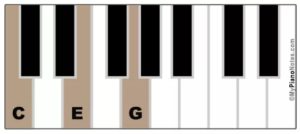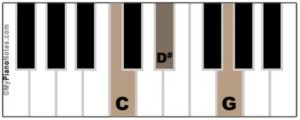Tips for Beginners to Get Better with Piano Chords
One of the things which make piano one of the most beautiful instruments is the music it produces when multiple notes are played together. I am talking about chords. As you might already know that chords are when 2 or more notes are played together on a Piano. Chords can often be intimidating for beginners. So our topic of discussion is centered around chords and how to get better with them.
Focus on Basic Chords only
As a Beginner it’s recommended to start with the Basic chords only. If you jump at the advanced chords straightaway you will not be able to learn chords effectively. It would be unrealistic to think that you would be able to play piano like Beethoven in a few days.
Piano Chords can be broadly divided into 4 Categories
- Major Chords
- Minor Chords
- Augmented Chords
- Diminished Chords
Of these 4 Categories, Augmented & Diminished Chords are the advanced chords and less used as compared to Major & Minor chords. So our goal would be to master the basic chords only. And once you are comfortable with the basics, you can jump and learn the advanced chords on your own. You can use this piano chords resource to learn more about the advanced chords later. Let’s Begin with the basics.
Get Clear the with Steps
For Beginners to understand and form chords on their own, it’s of utmost importance to understand steps.
In Piano there are 2 types of steps.
- Half Step – When you jump from one note to to its adjacent note, it will be a half step. Example of Half Steps – C to C#, E to F, F to F#, etc.
- Full Step – Two Half Steps Make a Full Step.
To form chords, we just need to care about the half steps and be able to count them quickly
Forming the Major Chords
You can form a Major Chord from any note. Major chords are played with your Thumb, Middle & Little fingers. It’s important to use these fingers as they make jumping from one chord to another chord much easier.
Let’s try to form a Major chord using the key c.
Step 1 – Place your Thumb on the C Key.
Step 2 – Jump 3 Half Steps, and place your middle finger on the key at the 4th Half Step. In this case, it will be ‘E’.
Step 3 – Jump 2 Half steps from E, and place your little finger on key at the 3rd Half Step. In this case, it will be ‘G’.
Step 4 – Play these notes together.
C – E – G together form our C Major Chord. You can use this process to form any chord on your own. And you don’t even need a Chords chart for reference, if you are able to learn this rule and practice Major Chords accordingly.
Give it a try! Before Reading further and try to see if you can form the C# Major Chord on your own
Did you get the keys C# – F – G# ? If yes, then you’ve learned how to form major chords on piano. Let’s proceed to Minor Chords.
Forming the Minor Chords
Minor Chords are played using the same fingers as the major chords. But with one difference.
In case of Minor Chords, you skip 2 Half Steps and then 3 Half steps. This is the opposite of what we do to form major chords. But I wouldn’t recommend this pattern to form the Minor chords.
A Good Advice would be to first properly practice and memorise all the Major chords. Once you know how to play the Major chord, all you have to do is shift your middle finger to the note on the left by a half step. This will give you your Minor Chord.
Let’s see if you can form the C Minor Chord on your own.
Did you get the following Keys?
If you did get these keys exactly, congratulations on mastering the minor chords as well.
A Practice Program
For a Beginner, just learning all the chords is not good enough. You need to be able to play all the chords without spending too much time thinking which chord is where and forming it all over again.
Hence, here is a simple practice method for chords you can use to get better at the basic chords.
- Pick any 6 Chords Randomly.
- Play them one by one in forward and backward directions. Do this until you can do it with speed and no mistakes.
- Once you have mastered the sequential progression. It’s time to mix things up.
- Change the sequence of the chords in any random order, and then try to play them quickly in the new sequence you decided.
- Repeat this exercise with Random Set of Chords, and Random Sequences.
This process will enable your fingers to quickly move from one chord to another, and help you get better at them.
Remember that this will come to you with practice, and it is not something which you can learn in a day or a week. So whenever you get a chance, remember to practice the chords.
Bonus Video
Beginners often song for an actual song they can practice on the piano. Here is Video tutorial for Jingle Bells with written letter notes. You can practice this song and learn to play it with both hands.
The post Tips for Beginners to Get Better with Piano Chords appeared first on Tab and Chord.


Comments
Post a Comment